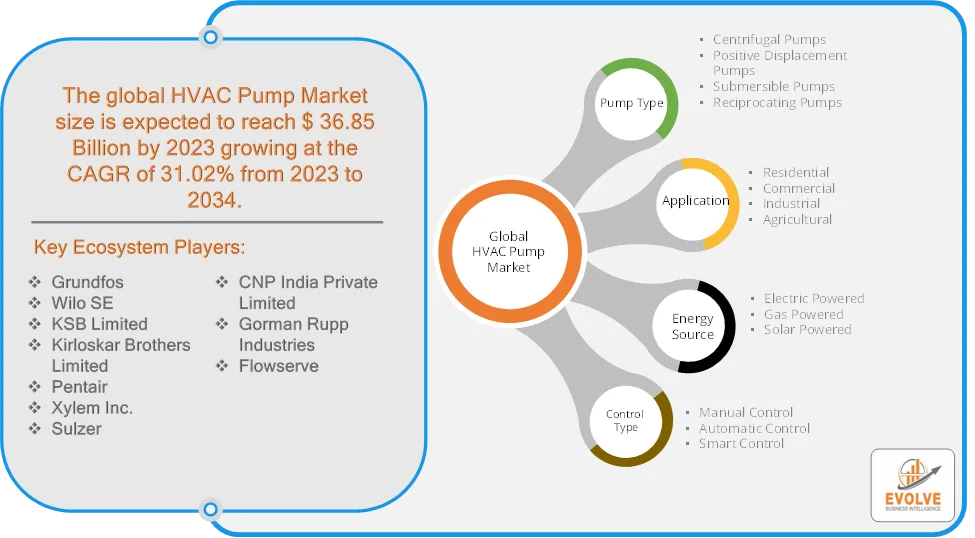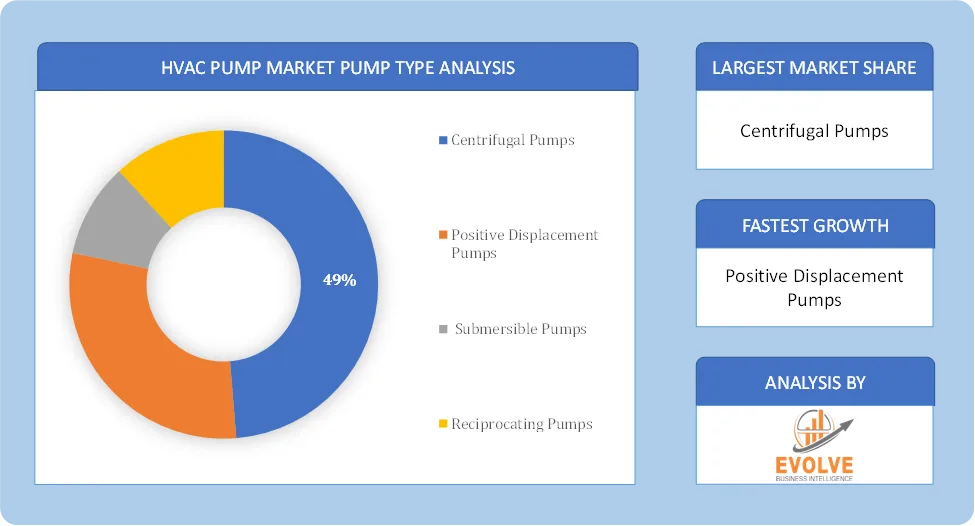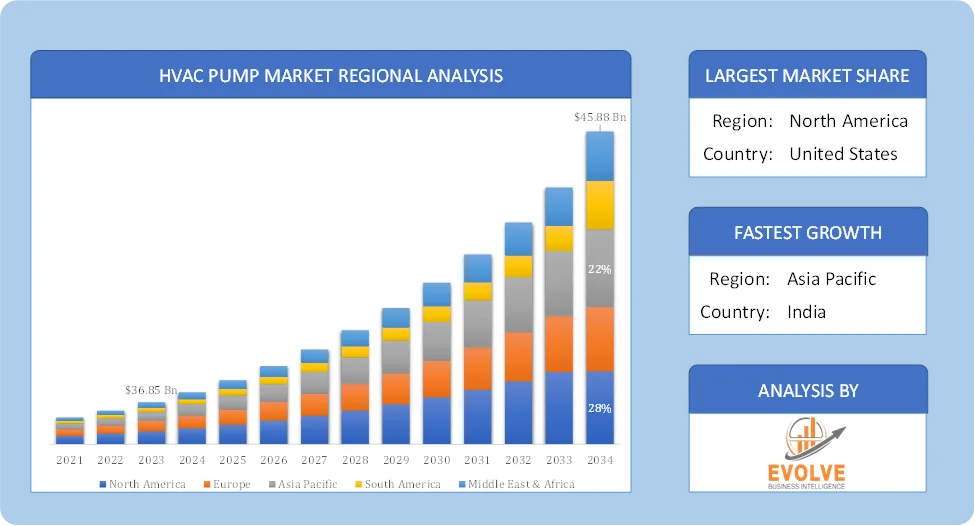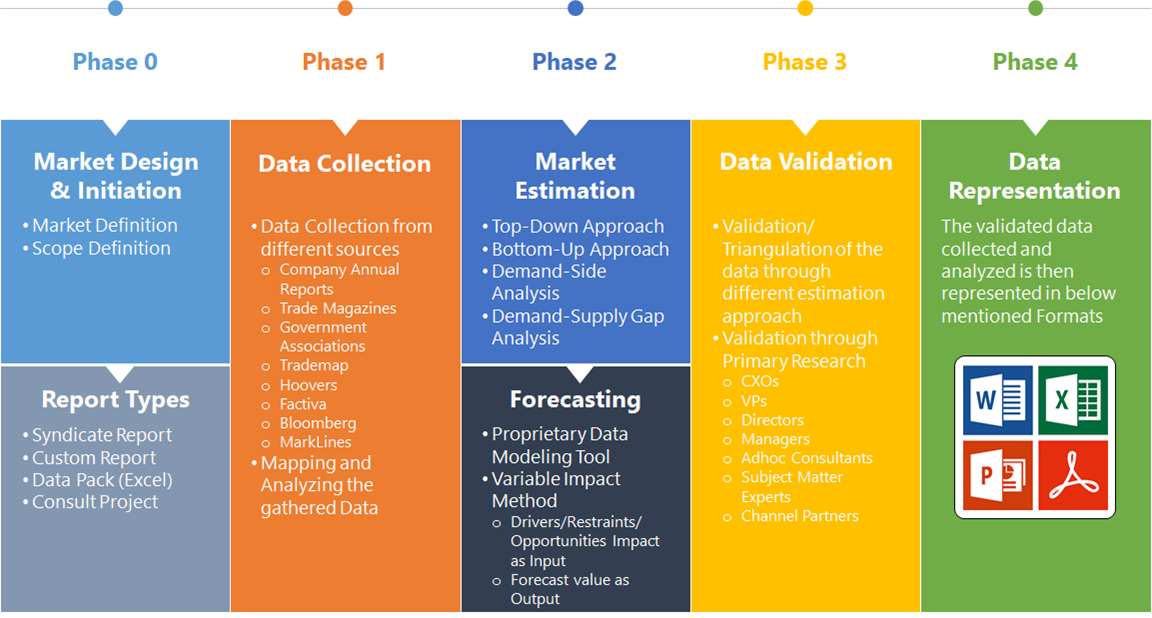HVAC Pump Market Overview
The HVAC Pump Market size accounted for USD 36.85 Billion in 2023 and is estimated to account for 37.02 Billion in 2024. The Market is expected to reah USD 45.88 Billion by 2034 growing at a compound annual growth rate (CAGR) of 31.02% from 2024 to 2034. The HVAC (Heating, Ventilation, and Air Conditioning) Pump Market is a crucial segment of the HVAC industry, providing essential pumping solutions for heating and cooling applications across residential, commercial, and industrial sectors. These pumps help circulate water, refrigerants, and other fluids through HVAC systems to maintain optimal indoor temperature and air quality.
The HVAC pump market is experiencing robust growth driven by the increasing demand for energy-efficient solutions, urbanization, industrialization, and technological advancements. The trend towards smart and variable-speed pumps, along with a growing emphasis on sustainability.
Global HVAC Pump Market Synopsis
 HVAC Pump Market Dynamics
HVAC Pump Market Dynamics
The major factors that have impacted the growth of HVAC Pump Market are as follows:
Drivers:
Ø Increasing Demand for Energy-Efficient HVAC Systems
Rising energy costs and environmental concerns are pushing industries and consumers to adopt high-efficiency HVAC pumps with features like variable speed drives (VSDs) and smart control systems to optimize energy consumption. Governments and regulatory bodies are implementing stringent energy efficiency standards, promoting the adoption of advanced HVAC pump technologies. The integration of IoT-enabled HVAC pumps allows for remote monitoring, predictive maintenance, and real-time performance optimization, improving operational efficiency and advanced pumps with automation features reduce energy wastage and extend the lifespan of HVAC systems.
Restraint:
- High Initial Investment and Installation Costs and High Operational Costs
Advanced HVAC pumps with smart controls, variable frequency drives (VFDs), and IoT integration come with higher upfront costs, making them less affordable for small businesses and residential users. Retrofitting or upgrading existing HVAC systems with modern pumps often requires additional investments in system compatibility and infrastructure modifications. Regular maintenance, repairs, and servicing of HVAC pumps can be expensive, especially in commercial and industrial setups where downtime is costly and improper maintenance or pump inefficiencies can lead to higher energy consumption and operational costs over time.
Opportunity:
⮚ Growing Demand for Smart and IoT-Enabled HVAC Pumps
IoT integration and smart controls allow real-time monitoring, predictive maintenance, and remote operation, improving energy efficiency and the rising adoption of smart buildings and automated HVAC systems presents a significant opportunity for manufacturers to offer connected and intelligent pump solutions. The integration of solar-powered and geothermal HVAC systems presents an opportunity for innovative HVAC pumps that complement these renewable energy sources and governments promoting net-zero energy buildings and sustainable cooling solutions drive demand for eco-friendly and energy-saving pumps. The rapid expansion of data centers, IT infrastructure, and industrial cooling applications is boosting demand for high-capacity, reliable HVAC pumps and the shift towards liquid cooling solutions in data centers presents an emerging opportunity for pump manufacturers.
HVAC Pump Market Segment Overview
Based on Pump Type, the market is segmented based on Centrifugal Pumps, Positive Displacement Pumps, Submersible Pumps, Reciprocating Pumps. The Reciprocating Pumps segment dominant the market.
By Application
Based on Type, the market segment has been divided into Residential, Commercial, Industrial, Agricultural. The Residential segment dominant the market. The Residential segment stands out due to the growing trend of smart home technologies and energy-efficient solutions, as homeowners increasingly prioritize climate control and comfort. Commercial applications are also crucial, driven by the expansion of buildings and infrastructure requiring effective HVAC systems for optimal climate management.
By Energy Source
Based on Application, the market segment has been divided into Electric Powered, Gas Powered, Solar Powered. The Electric Powered segment dominant the market. Electric-powered HVAC pumps are prevalent due to their efficiency and lower operational costs, making them a preferred choice for many applications. Meanwhile, gas-powered pumps offer significant advantages in areas where electricity is less reliable, ensuring continuous operation. The rising popularity of solar-powered solutions aligns with global trends towards sustainability, making it an important aspect of market growth as more consumers and businesses seek eco-friendly alternatives.
By Control Type
Based on End Use Hospital, the market segment has been divided into Manual Control, Automatic Control, Smart Control. The Smart Control segment dominant the market. Smart Control is rising in prominence, characterized by advanced technology such as IoT integration, enabling predictive maintenance and energy savings. This segment’s growth is supported by increasing energy efficiency regulations and the rising demand for automated solutions, positioning it as a significant driver in the HVAC Pump Market industry.
Global HVAC Pump Market Regional Analysis
Based on region, the global HVAC Pump Market has been divided into North America, Europe, Asia-Pacific, the Middle East & Africa, and Latin America. North America is projected to dominate the use of the HVAC Pump Market followed by the Asia-Pacific and Europe regions.
 North America HVAC Pump Market
North America HVAC Pump Market
North America holds a dominant position in the HVAC Pump Market. The United States and Canada lead the market due to high demand for energy-efficient HVAC systems in residential, commercial, and industrial buildings. Growth in data centers and smart buildings further supports the demand for high-performance HVAC pumps. Rising adoption of IoT-enabled and smart HVAC solutions and expansion of green buildings and LEED-certified projects.
Asia-Pacific HVAC Pump Market
The Asia-Pacific region has indeed emerged as the fastest-growing market for the HVAC Pump Market industry. Asia-Pacific region is fastest-growing region, driven by rapid urbanization, industrialization, and construction in China, India, Japan, and Southeast Asia. Massive demand for residential and commercial HVAC systems due to extreme climate conditions and rising disposable income and smart cities and infrastructure projects in India and China are boosting the adoption of energy-efficient HVAC pumps. It has strong growth in construction and industrial sectors and increasing adoption of solar and geothermal HVAC systems.
Competitive Landscape
The global HVAC Pump Market is highly competitive, with numerous players offering a wide range of software solutions. The competitive landscape is characterized by the presence of established companies, as well as emerging startups and niche players. To increase their market position and attract a wide consumer base, the businesses are employing various strategies, such as product launches, and strategic alliances.
Prominent Players:
- Grundfos
- Wilo SE
- KSB Limited
- Kirloskar Brothers Limited
- Pentair
- Xylem Inc.
- Sulzer
- CNP India Private Limited
- Gorman Rupp Industries
Scope of the Report
Global HVAC Pump Market, by Pump Type
- Centrifugal Pumps
- Positive Displacement Pumps
- Submersible Pumps
- Reciprocating Pumps
Global HVAC Pump Market, by Application
- Residential
- Commercial
- Industrial
- Agricultural
Global HVAC Pump Market, by Energy Source
- Electric Powered
- Gas Powered
- Solar Powered
Global HVAC Pump Market, by Control Type
- Manual Control
- Automatic Control
- Smart Control
Global HVAC Pump Market, by Region
- North America
- US
- Canada
- Mexico
- Europe
- UK
- Germany
- France
- Italy
- Spain
- Benelux
- Nordic
- Rest of Europe
- Asia Pacific
- China
- Japan
- South Korea
- Indonesia
- Austalia
- Malaysia
- India
- Rest of Asia Pacific
- South America
- Brazil
- Argentina
- Rest of South America
- Middle East & Africa
- Saudi Arabia
- UAE
- Egypt
- South Africa
- Rest of Middle East & Africa
| Parameters | Indicators |
|---|---|
| Market Size | 2034: USD 45.88 Billion |
| CAGR (2024-2034) | 31.02% |
| Base year | 2022 |
| Forecast Period | 2024-2034 |
| Historical Data | 2021 (2017 to 2020 On Demand) |
| Report Coverage | Revenue Forecast, Competitive Landscape, Growth Factors, and Trends |
| Key Segmentations | Pump Type, Application, Energy Source, Control Type |
| Geographies Covered | North America, Europe, Asia-Pacific, South America, Middle East, Africa |
| Key Vendors | Grundfos, Wilo SE, KSB Limited, Kirloskar Brothers Limited, Pentair, Xylem Inc., Sulzer, CNP India Private Limited, Gorman Rupp Industries and Flowserve. |
| Key Market Opportunities | · Growing Demand for Smart and IoT-Enabled HVAC Pumps · Rising Adoption of Renewable Energy in HVAC Systems |
| Key Market Drivers | · Increasing Demand for Energy-Efficient HVAC Systems · Technological Advancements and Smart HVAC Solutions |
REPORT CONTENT BRIEF:
- High-level analysis of the current and future HVAC Pump Market trends and opportunities
- Detailed analysis of current market drivers, restraining factors, and opportunities in the future
- HVAC Pump Market historical market size for the year 2021, and forecast from 2023 to 2033
- HVAC Pump Market share analysis at each product level
- Competitor analysis with detailed insight into its product segment, Government & Defense strength, and strategies adopted.
- Identifies key strategies adopted including product launches and developments, mergers and acquisitions, joint ventures, collaborations, and partnerships as well as funding taken and investment done, among others.
- To identify and understand the various factors involved in the global HVAC Pump Market affected by the pandemic
- To provide a detailed insight into the major companies operating in the market. The profiling will include the Government & Defense health of the company’s past 2-3 years with segmental and regional revenue breakup, product offering, recent developments, SWOT analysis, and key strategies.










